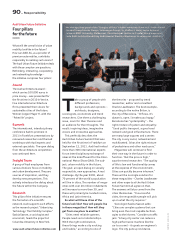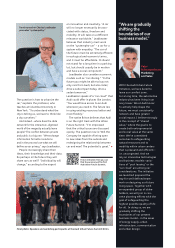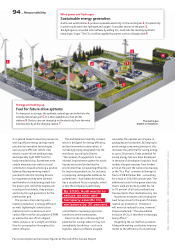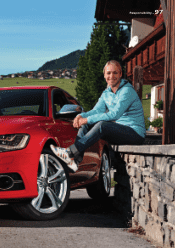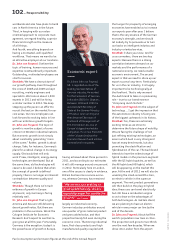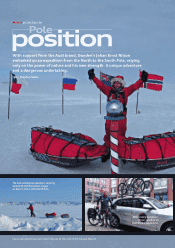Audi 2011 Annual Report Download - page 101
Download and view the complete annual report
Please find page 101 of the 2011 Audi annual report below. You can navigate through the pages in the report by either clicking on the pages listed below, or by using the keyword search tool below to find specific information within the annual report.
Fuel consumption and emission fi gures at the end of the Annual Report
The
t
ransition phase is the
greatest challenge. It is
diffi cult, but also par-
ticularly intriguing. And
you have to fi nd a very good compro-
mise so that everything fi ts together,”
says Magdalena Neuner. And Jürgen
Königstedt agrees.
The biathlete and the Head of
V8/V10 Gasoline Engine Development
at AUDI AG are of one mind, but with
reference to two diff erent worlds – with
astonishing parallels. The professional
athlete is describing the transition
between cross-country skiing and
shooting. The Audi engineer is talking
about Audi cylinder on demand, a
fascinatingly effi cient solution where
an eight-cylinder engine temporarily
acts as a four-cylinder unit.
Magdalena Neuner doesn’t need
a lot of muscle to shoot. And the new
Audi S6 doesn’t need eight cylinders
to drive steadily at a moderate speed.
Magdalena Neuner always has her
muscles “on board.” Just like the
Audi S6 with the eight cylinders of its
4.0 TFSI engine. They are defi nitely
needed, but are not used all the time.
What sounds like a confl ict of aims
is cleared up when it comes to making
clever use of potential. Rationing
energy: muscle in the case of humans,
fuel in the car. Cross-country skiing
is all about time; shooting is about
precision. When the Audi S6 performs
an impressive sprint with eight cylin-
ders, it saves time. With four cylinders,
it saves fuel.
The solution is very sophisticated.
“I have been training since I was a
child,” reveals Magdalena Neuner. “The
most important thing is to prepare the
body and the mind for it.” Mind and
body. Brain and heart. Electronics and
engine. Software and hardware.
The transition in the human: a fl ow of
data between the brain and the heart
muscle. Magdalena Neuner’s pulse
at the end of a skiing leg is 180 beats
per minute. “But I reduce my pace
100 to 150 meters before the fi ring
range,” she says. “That’s also when the
concentration phase begins.”
The transition in a car: a fl ow of data
between the electronics and the V8
engine. The ignition and fuel injection
for cylinders 5-8-3-2 are deactivated.
A zero-lift cam on the cam shafts is
activated and holds the respective
intake and exhaust valves closed. The
V8 becomes a V4.
Human parameters: Neuner’s pulse is
still 170 at the fi rst shot, 150 at the
last one. A tight range at a high level.
Engine parameters: engine speed
between 960 and 3,500 rpm; in third
gear or above; coolant temperature
at least 30° Celsius. No major move-
ments of the gas pedal, but rather a
steady load.
Why these parameters?
“Shooting would become much
more diffi cult at a lower pulse,” says
the biathlete. It sounds like a paradox.
Shallow breathing and a relatively
high pulse make it easier for biathletes
to aim, while also helping them to
get started on the next skiing leg.
Harmony in athletics. The time for the
previous leg is compromised, but
only by a few seconds. In the interest
of the overall result.
“If we were to shut off the four
cylinders for just a very brief time, fuel
consumption would in fact be slightly
higher,” explains the development
engineer. It sounds like a paradox.
Likeable
record-holder
Magdalena Neuner
Born in 1987, Magdalena Neuner
fi rst stood on alpine skis at
the age of four. She took up the
biathlon when she was nine.
Neuner’s career saw her go quickly
from winning the German
School Cup to claiming the Junior
World Championship. The native
of Wallgau was just 20 years old
in 2007 when she took part in
her fi rst World Championships in
Antholz and emerged as the most
successful athlete. That same year
she was named “Female Athlete
of the Year.” In 2008, Neuner
became the youngest biathlete
ever to win the World Cup. And
she was the most successful
female German athlete at the
2010 Winter Olympics. She set a
new record by winning ten gold
medals at the 2011 Biathlon
World Championships. Last
December, she announced her
intention to end her career after
the season.
“I am completely
happy and
contented because
everything is
perfect, just the
way I imagined it.”
Magdalena Neuner
It’s about the smart
use of potential.
Rationing energy: muscle
in the case of humans,
fuel in the car.
Magdalena Neuner has perfected the tran-
sition from cross-country skiing to
shooting in the biathlon over many years.
PHOTOS | TOBIAS HASE/DPA PICTURE-ALLIANCE; AUDI AG; PICTURE-ALLIANCE/AUGENKLICK/LACY PERENYI; GETTY IMAGES/MEDICALRF.COM; ACTION PRESS




